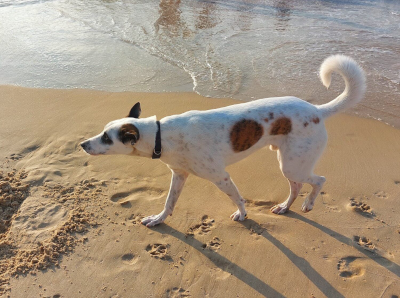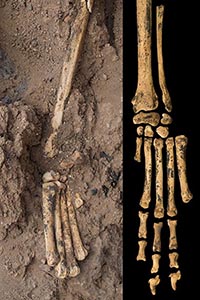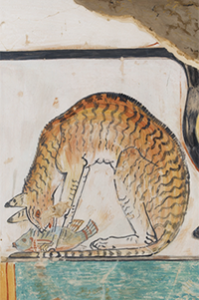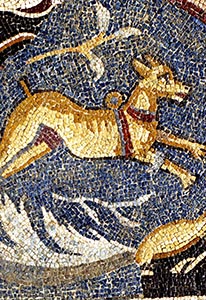
Not a Friend of ASOR yet? Sign up here to receive ANE Today in your inbox weekly!

October 2023
Vol. 11, No. 10
Dogs as Part of the Social Fabric of Iron Age Settlements
By Lidar Sapir-Hen and Deirdre N. Fulton
The interaction of humans with their best friend, the dog, is extensively studied. In historical periods, evidence for human and dog interactions in the Levantine context is most evident in the Persian-Early Hellenistic periods (5th – 3rd century BCE) when the practice of multiple dog burials became a prominent phenomenon in several archaeological sites. The discovery of these outstanding burials has attracted most of the scholarly attention, and it consequently directed the research on dogs in the Ancient Near East, even in the earlier Iron Age (end of 2nd millennium – first half of the 1st millennium BCE), to focus solely on burial contexts.
While such studies focus on the post-mortem exploitation of dogs — namely their use in ritual or their possible consumption — the role of Levantine dogs during their lives has been left unexplored. Dogs may have had many roles, as we know from their place in many cultures today. We thus have explored the role of dogs in the social fabric of the Iron Age through a comparative study of the evidence from settlements. Settlements of the Iron Age included both urban and rural settings (Figure 1). These settlements were characterized by social hierarchy, trade relations, and an increasing impact on the local environment, including expanding site size (compared to earlier periods) and changing landscapes by active deforestation. The people of these settlements were engaged in herding livestock (sheep, goat) and exploiting it for meat, milk, and wool, and in plowing fields for grain agriculture (with cattle). They were also occasionally involved in game hunting, although it was a very minor contribution to their diet.
Although dog remains have been found in many excavations of the Iron Age, they have not received the same research attention as other animals (mainly livestock) and have oftentimes been qualified as an unusual find since they generally account for a small percentage of the overall faunal assemblage. At the same time, archaeological interpretation of dog burials often relies on studies of the Hebrew Bible, which has often been seen as highlighting the poor or ambivalent treatment of dogs in the texts. Based on these factors, deciphering the dogs’ role in the Iron Age settlements is not a straightforward task. If dogs were used as aids in hunting or herding, such a role is not easily visible in the archaeological record.
To decipher dogs’ role(s), we created a comprehensive database, combining both archaeological and textual data. We relied on various types of evidence, including dog presence at the site, the concurrent presence of other animals and the intensity of their exploitation (herding livestock and hunting game), and textual references to dogs that may hint at their perception by humans.

Figure 2: Sky, a modern mixed-Canaanite dog. He wishes he could herd and hunt. Photograph: Lidar Sapir-Hen
On a side note, our database did not allow for the identification of dog breeds. Most dog breed types are a later invention, and thus any discussion of the matter is difficult. However, when dogs from the Iron Age in the southern Levant were identified to breed, most often based on their body size, they were generally identified as pariah dogs, and compared in size and robustness to the modern “Canaanite” dog (Figure 2).
A careful examination of the archaeological record from ~90 published faunal assemblages revealed that dogs were present in 2 out of 3 sites (Figure 3). This means that dogs were very common in the settlements of this period and that their presence should be expected in faunal assemblages. Examining the reports, we noticed that their remains were commonly scattered among the other animal remains and were often not articulated (Figure 4). This implies that their remains at the site were not the result of deliberate burial. In most cases, we could correlate dogs’ presence on site with evidence for the high intensity of herding of sheep and goats, which was the most common activity of the human population. The dogs in these sites were probably used either as aids in herding or as guardians of livestock, against predators and thieves.
Dogs were also probably used for hunting, although based on the low percentage of wild taxa found at most sites, this was a very minor activity in the Iron Age. As we could not always correlate dogs’ presence on site with evidence for hunting, it is possible that hunting could also take place without them. Still, rock art from northwestern Saudi Arabia depicts dogs — often identified as Canaanites/Levantine dogs — assisting in various hunting tasks beginning in the Neolithic period, and continuing into the Bronze Age, when they were depicted assisting in hunting an ungulate.
When we examined textual evidence, this also revealed that dogs were an active part of village life. While the negative connotations of dogs are widely cited by researchers — particularly related to the food laws in Leviticus 11 and their association with scavenging in 1 and 2 Kings — we noticed that there are several other depictions of dogs, that highlight them in different roles. For example, dogs as guardians of villages may be seen in Exodus 11:7. In Isaiah 56:10, Israel’s guards are likened to silent dogs: “Israel’s sentinels are blind, they are without knowledge; they are all silent dogs that cannot bark.” Dogs as hunters are also depicted in passages such as Psalm 22: 16: “For dogs are all around me; a company of evildoers encircle me.” While both the Isaiah and Psalm passages present what could be interpreted as negative depictions of dogs, their roles as guards and hunters is nevertheless evident.
There are also several passages that compare warriors to dogs, most notably in Judges 7:4-5 when Gideon’s warriors are only selected if they lap up water like dogs. The Hebrew word for dog, kalbi, also appears in the name of Caleb, who is depicted as a warrior throughout the book of Joshua. Members of the elite likening themselves to dogs, particularly in the presence of a king, are found in stories such as 2 Kgs 8:13, and in other examples in the Assyrian and Babylonian contexts. We argue, thus, that if dogs were only thought of as unclean scavengers, this close association between warriors and the fierceness of dogs makes little sense.
Altogether, the faunal and textual evidence point to the common presence of dogs in southern Levantine sites, which may help us move away from understanding Iron Age dogs as simply “unclean” or pariah animals (based on earlier readings of the textual evidence), or primarily related to a cultic activity (owing to the minor attention paid to non-burial contexts of dogs), to understanding dogs as an important part of Levantine communities.
Lidar Sapir-Hen is Senior Lecturer at the Department of Archaeology and Ancient Near Eastern Cultures and Head of the Laboratory of Zooarchaeology at Tel Aviv University. Deirdre N. Fulton is Associate Professor in the Department of Religion at Baylor University. Their article, “A Dog’s Life in the Iron Age of the Southern Levant: Connecting the Textual and Archaeological evidence”, recently appeared in the Oxford Journal of Archaeology.
Want To Learn More?
 Our Early Neolithic Canine Companions
Our Early Neolithic Canine Companions
By Lisa Yeomans
Dogs have been faithful human companions for millennia. New finds from a once lush region of eastern Jordan help fill in the picture of how the relationship developed. Read More
Pictures of Restraint: Hunting Carnivores on Mosaics from the Roman and Byzantine Periods
By Amir Gorzalczany and Baruch Rosen
Many cultures hunt with animals. Roman mosaics give us insights about different techniques for restraining animals but also about the ideologies of their patrons. Read More
Where Do Cats Come From?
By Claudio Ottoni
Across the centuries, cats have accompanied people all over the world along trade routes. There are currently more than 1.2 billion feral and pet cats across all continents except Antarctica. But where do they come from? Read More
